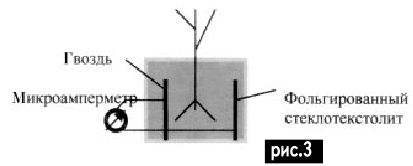
|
|
ENCYCLOPEDIA OF RADIO ELECTRONICS AND ELECTRICAL ENGINEERING How do plants react to electricity? Encyclopedia of radio electronics and electrical engineering
Encyclopedia of radio electronics and electrical engineering / Home, household, hobby Let's start with the fact that the agricultural industry is destroyed to the ground. What's next? Is it time to collect stones? Isn't it time to unite all creative forces in order to give the villagers and summer residents those novelties that will allow them to dramatically increase productivity, reduce manual labor, find new ways in genetics ... I would suggest that the readers of the magazine be the authors of the column "For the Village and Summer Residents". I'll start with the old work "Electric field and productivity." In 1954, when I was a student at the Military Communications Academy in Leningrad, I became passionately interested in the process of photosynthesis and carried out an interesting test with growing onions on a windowsill. The windows of the room in which I lived faced the north, and therefore the bulbs could not receive the sun. I planted in two elongated boxes of five bulbs. He took the earth in the same place for both boxes. I didn’t have any fertilizers, i.e. were created, as it were, the same conditions for growing. Above one box from above, at a distance of half a meter (Fig. 1), he placed a metal plate, to which he attached a wire from a high-voltage rectifier +10 V, and stuck a nail into the ground of this box, to which he connected the "-" wire from the rectifier.
I did this so that, according to my theory of catalysis, the creation of a high potential in the plant zone will lead to an increase in the dipole moment of the molecules involved in the photosynthesis reaction. And the days of trials dragged on. Already after two weeks, I discovered that in a box with an electric field, plants develop more efficiently than in a box without a "field"! Fifteen years later, this experiment was repeated at the institute, when it was necessary to grow plants in a spacecraft. There, being closed from magnetic and electric fields, plants could not develop. It was necessary to create an artificial electric field, and now plants survive on spaceships. And if you live in a reinforced concrete house, and even on the top floor, don't your plants in the house suffer from the absence of an electric (and magnetic) field? Stick a nail into the ground of a flower pot, and connect the wiring from it to a heating battery that has been cleaned of paint or rust. In this case, your plant will approach the conditions of life in the open space, which is very important for plants and for humans too! But my trials didn't end there. Living in Kirovograd, I decided to plant tomatoes on the windowsill. However, winter came so quickly that I did not have time to dig up tomato bushes in the garden to transplant them into flower pots. I came across a frozen bush with a small living process. I brought it home, put it in the water and... Oh, joy! After 4 days, white roots grew from the bottom of the process. I transplanted it into a pot, and when it grew with shoots, I began to get new seedlings in the same way. All winter I ate fresh tomatoes grown on the windowsill. But I was haunted by the question: is such cloning possible in nature? Perhaps, old-timers in this city confirmed to me. Possibly, but... I moved to Kyiv and tried to get tomato seedlings in the same way. I didn't succeed. And I realized that in Kirovograd I succeeded in this method because there, at the time when I lived, water was supplied to the water supply network from wells, and not from the Dnieper, as in Kiev. Groundwater in Kirovograd has a small amount of radioactivity. This is what played the role of a growth stimulator of the root system! Then I applied +1,5 V from the battery to the top of the tomato sprout, and "-" brought the vessel where the sprout stood to the water (Fig. 2), and after 4 days a thick "beard" grew on the sprout in the water! So I managed to clone the offshoots of a tomato.
Recently, I got tired of watching the watering of plants on the windowsill, I stuck a strip of foil fiberglass and a large nail into the ground. I connected wires from a microammeter to them (Fig. 3).
The arrow immediately deviated, because the earth in the pot was damp, and the copper-iron galvanic pair worked. A week later I saw how the current began to fall. So, it was time for watering ... In addition, the plant threw out new leaves! This is how plants respond to electricity. Author: N. Golovin
Machine for thinning flowers in gardens
02.05.2024 Advanced Infrared Microscope
02.05.2024 Air trap for insects
01.05.2024
▪ The thinnest 13-megapixel module from Toshiba ▪ PIONEER car system with hard drive ▪ How many genes does a person have ▪ Found a place with lifeless soil ▪ The neck is the weak point of a football player
▪ section of the site Mobile communications. Article selection ▪ article This May-spoiler, this May-sorcerer blows fresh with his fan. Popular expression ▪ article Why is Pokémon games banned in Saudi Arabia? Detailed answer ▪ article Common holly. Legends, cultivation, methods of application
Home page | Library | Articles | Website map | Site Reviews www.diagram.com.ua |






 Arabic
Arabic Bengali
Bengali Chinese
Chinese English
English French
French German
German Hebrew
Hebrew Hindi
Hindi Italian
Italian Japanese
Japanese Korean
Korean Malay
Malay Polish
Polish Portuguese
Portuguese Spanish
Spanish Turkish
Turkish Ukrainian
Ukrainian Vietnamese
Vietnamese



 Leave your comment on this article:
Leave your comment on this article: